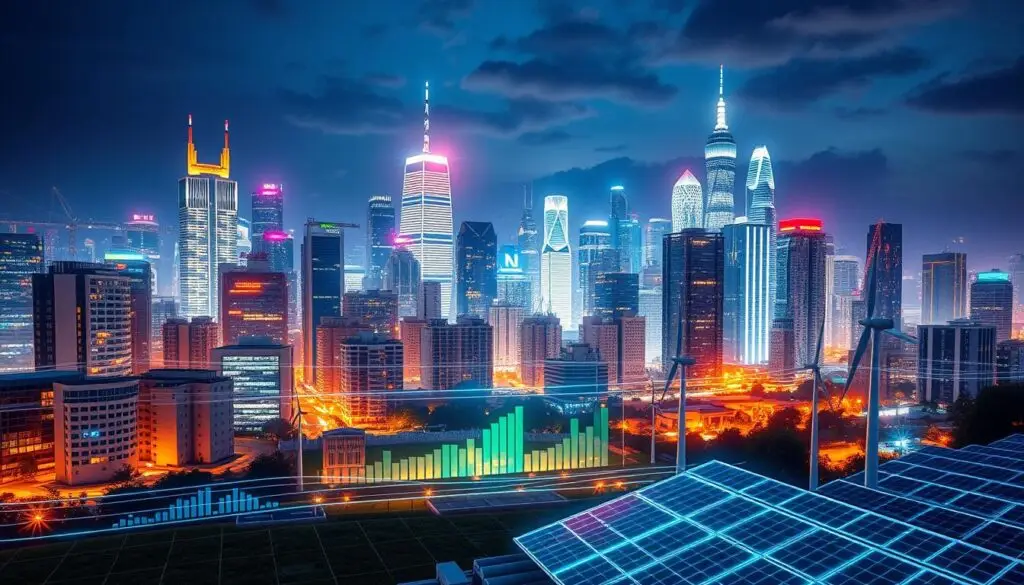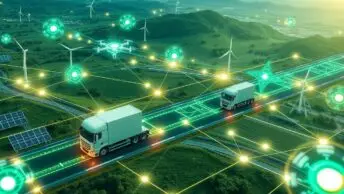In today’s world, saving energy is crucial. AI in Energy Management offers a promising way to use power wisely. This is key as we face a growing energy crisis. EU buildings use nearly 40% of energy and contribute to 36% of greenhouse gas emissions1. This shows how important it is to find sustainable energy solutions. AI technologies bring the hope of making buildings more energy-efficient and saving money. This helps reduce harmful emissions and brings financial gains.
Adding AI into buildings is changing the game. It uses sensors and IoT devices to make energy use better and improve buildings. Starting an AI system might cost from $50,000, depending on what it does. But, it saves money in the long run through lower bills and less repairs1. Many countries now encourage buildings to use smart technologies. This motivates everyone to practice energy efficiency for a greener future1.
AI’s future in energy systems looks very promising. The AI market could hit over 740 billion US dollars by 20302. AI can predict when machines will break, reducing costs. Companies like Siemens prove this. Also, AI smart grids help use renewable energy better. They adjust how much energy to produce or store based on current needs2.
Switching to smarter, AI-driven systems does more than just improve operations. It deeply affects our environment and economy. These technologies offer a path to a world where we do more with less. As we explore AI’s benefits in energy management, we see how innovation can solve our urgent energy needs. It’s about creating a world where we live sustainably.
The Imperative of Energy Efficiency in Modern Buildings
The search for better energy use is key in today’s building designs. Urban growth brings challenges to lower pollution and manage costs. Making buildings more efficient saves money and helps the earth.
Understanding the Environmental Impact of Energy Use
Cost Savings through Smart Building Innovations
Challenges in Retrofitting Traditional Infrastructure with AI
Updating old buildings with AI is tough. The costs and technical challenges are big barriers. Yet, overcoming these is key for energy savings and better efficiency3.
AI not only improves how we manage stocks but also cuts energy waste in buildingsLearn more about AI efficiency in handling materials.
AI in Energy Management: Transition to Smart Buildings
Artificial intelligence (AI) is changing old buildings into smart ones. It uses sensors and IoT tech to gather data. This lets AI make real-time changes for saving energy.
Sensors and IoT Devices: The Backbone of Intelligent Systems
Smart buildings depend on sensors and IoT gadgets. These monitor temperature, humidity, and energy use. AI in social media marketing uses similar data to engage users better.
Real-time Data Processing with AI for Sustainable Operations
AI analyzes data from devices to save energy. It makes quick adjustments, cutting costs and promoting eco-friendliness. Predictive tools guess when energy use will peak and manage output to avoid waste5.
Predictive Maintenance: A Proactive Approach to Energy Saving
AI in building management shows buildings are evolving. They become places of efficiency, sustainability, and tech. This marks a future where we use energy in the most effective way.
Smart Grids: The Confluence of Renewable Energy and AI
Smart grids gaining AI brings a big leap in using renewable energy. With AI, these grids adjust to energy needs, making power more stable and dependable. They look at lots of data to see how energy is used and make sure it’s shared out right. This is a key step towards making energy use more green7.
Also, adding blockchain to smart grids makes things more clear and effective. In France, companies like EkWateur show how blockchain can make energy use easier to track. It changes the way we keep an eye on and handle our energy use. This means better grid reliability and gives users more control with up-to-the-minute billing7.
Blockchain also lets people sell extra energy directly to each other. This is good for both sides: users can sell what they don’t need, and green energy gets used more. It encourages saving energy when demand is high. Plus, with help from subsidies, renewable energy is becoming a bigger part of our power supply7.
AI doesn’t just manage energy flow; it also helps bring new renewable options into the mix. It makes sure the energy from these sources fits well with what the grid needs. This smooths out the bumps in adding renewables to our energy supply7. Tools like Google’s DeepMind prove that machine learning can really boost how much energy we get. It does this by brilliantly predicting energy needs8.
To wrap up, smart grids, renewable energy, and AI together are solving today’s energy challenges. They’re paving the way for future power systems that are smart, tough, and kind to both the planet and its people.
Energy Consumption Forecasting with Machine Learning
In the energy management field, new forecasting methods are key for better use of resources and power. Using Machine Learning algorithms like ARIMA, LSTM, and XGBoost has changed how businesses understand and predict their energy needs. This boosts their decision-making and how they operate.
Machine Learning algorithms, ARIMA works well for simple forecasting. LSTM is better for complex scenarios9.XGBoost is top-notch for structured data. These methods are very important in the energy industry. They make Energy Analytics stronger.
Crucial Role of Accurate Energy Predictions in Resource Allocation
Making right predictions about energy helps with using resources wisely. This reduces waste and extra costs9.Methods like PCA and SVM are good at spotting problems early. They also handle predicting changes in seasons well. By using these Machine Learning methods, we can adjust to shifting energy patterns better. This makes the energy systems we rely on more trustworthy and tough.
Machine Learning Algorithms Leading the Revolution in Forecasting
Deep Learning and mix methods, like decision trees and neural networks, are now key in the energy area for better forecasts10. These algorithms deal well with lots of data. They consider many factors such as holidays and the weather. This greatly improves how well they predict energy use. Transfer Learning and online learning in AI models help update data fast10.
Adding Explainable AI gives more clarity and meaning to these forecasts10. This builds trust and understanding about the predictions. The smart use and flexibility of these advanced methods not only help with managing resources. They also get energy systems ready to handle future needs in a smart and green way.
Demand Response Strategies Empowered by AI
This approach boosts how well operations work. It also supports energy plans that are key for new infrastructure.
AI plays a big part in better power use and distribution. It looks at a lot of data from smart meters and environmental clues12. This lets it accurately guess energy needs and adjust the Power Systems accordingly. Doing this stops the grid from being overwhelmed.
These instant adjustments keep the grid stable. They make sure power is always there, especially when lots of people need it. This helps avoid blackouts and lessens grid jams12.
Moreover, AI makes Demand Response not just efficient, but also cheaper. By knowing when peak demand happens, it adjusts power. This cuts down on costs for energy providers. These savings can then go to customers12. AI also guesses when equipment might fail and handles renewable energy better. This boosts Power Systems’ efficiency and dependability11.

AI Solutions in Renewable Energy Integration and Management
Weather Forecasting and Renewable Energy Source Predictability
Thanks to AI and lots of weather data, we can now forecast energy production very accurately14. This helps deal with the unpredictable nature of renewables. It also means we can plan better how to distribute energy.
Optimisation of Energy Storage with AI-Driven Analytics
AI analytics play a key role in planning and making quick decisions to better manage energy storage. By analyzing data, AI predicts when we’ll need more or less energy. This makes our energy systems more efficient and longer-lasting14. AI is paving the way for a smarter, sustainable energy future.
Advancements in Energy Analytics for Resource Optimisation
Artificial intelligence (AI) is transforming energy management by improving how we use resources. It makes our energy systems more efficient and resilient. Thanks to advanced data analytics, industries can manage energy better. This ensures resources are used wisely and the energy ecosystem stays robust.
Utilising Data for Streamlined Energy Distribution
AI-driven systems are changing energy management. They use machine learning and data from smart meters to make energy use smarter15. By examining all the data on energy use, these systems spot issues and wastage15. They adjust energy use based on current needs. This helps manage energy demand, especially during busy times15.
Improving Energy System Resilience through Intelligent Analysis
Energy analytics powered by AI do more than just improve operations. They make our energy systems stronger. For example, grid monitoring keeps an eye on the data to smooth out issues quickly16. Adding information like the weather helps predict energy needs better15. It also makes adding green energy sources easier15.
AI’s optimisation techniques lessen energy management risks. They help our planet by cutting down on harmful emissions and energy waste15. In short, using data analytics in energy makes the future brighter. It leads to a more durable, effective, and green energy world.
Sustainability and AI: A New Era in Energy Efficiency
Artificial Intelligence (AI) is changing how we use energy for the better. It’s making our energy use greener and more efficient across different sectors. With AI, monitoring, analysing, and managing energy systems have become easier. This leads to less energy waste and better performance17.
AI is not just about saving energy. It also helps in using more renewable energy sources. It predicts and manages energy use, making sure we get the most from both traditional and green energy18. This smart planning not only saves energy but also makes renewable sources like wind and solar more reliable19.
AI plays a big role in meeting sustainability goals. It helps us use energy smarter and cut down on harmful emissions. AI could also boost the global economy while reducing the damage to our planet by lowering CO2 emissions18.
But, turning to AI-powered energy systems fully has its challenges. These include the cost of starting and the need for workers to learn new AI skills. To make the most of AI in energy, we need continued innovation and support from regulations17.
Overcoming the Challenges in AI Adoption for Energy Conservation
Bringing AI into energy-saving efforts opens doors to better efficiency. But, it also brings challenges we need to overcome. Issues like data privacy, cybersecurity, and lacking skills are big hurdles.
Addressing Data Privacy and Security in a Connected World
In today’s digital era, keeping data safe is critical, especially for the energy sector using AI. Strong measures to protect data against cyber threats create a safer space for AI in saving energy. This sector is expected to grow to $5.23 billion by 2023, highlighting the urgency of securing our digital world20.
AI plays a key role in finding oil and gas reserves and spotting future infrastructure failures. This involves handling sensitive data that needs top-notch cybersecurity to stop breaches and build trust20.
Bridging the Skill Gaps in AI Technologies Deployment
The energy sector is facing a real challenge due to a lack of skilled AI workers. This skill gap makes it hard to embrace and make the most of AI solutions20.
We must invest in education and training. These should teach both the tech side of AI and the importance of cybersecurity. This way, professionals can push AI forward in energy use effectively.
By overcoming these challenges, the energy sector can enjoy greater energy efficiency and lower emissions. This effort is key in achieving the EU’s renewable energy goal of 42.5% by 203020.
AI and Consumer Behaviour: Educating End-users for Energy Conservation
AI is changing how we manage energy and making people more aware of saving it. With AI, energy companies can provide custom solutions that fit each person’s needs. The value of this market was $25.2 billion in 2020. It’s expected to grow to $49.6 billion by 2030. This shows how smart tech is becoming vital for managing energy21.
AI tailors energy use to what each person needs, keeping comfort and efficiency in mind. It uses data to make smart decisions, helping us use resources wisely. This way, people get more involved with smart energy systems and use energy better21.
Influencing Sustainable Practices through Customised AI Solutions
AI solutions make it easier for people to save energy by showing the personal benefits. This approach helps build a strong culture of sustainability. AI looks at different factors, like the time of day and weather, to predict and adjust energy use. This encourages people to save energy and creates a partnership between energy providers and users22.
Driving User Acceptance and Adoption of Smart Energy Systems
People like AI energy systems more when they see the benefits, such as lower bills and helping the planet. AI identifies areas where energy is wasted, teaching users to be more efficient. By analysing data, these systems find ways to save energy. This smart management reduces unnecessary energy use and improves living conditions. Thus, people are more open to using smart technologies for energy22.
Conclusion
The AI Revolution is changing how we manage energy, focusing on saving power and being green. These trends in AI promise a big change. They aim to cut down on harmful gases by making energy use smarter and promoting saving habits23. Machine Learning, for example, is playing a key role in making the power sector better. It helps by predicting power needs and keeping the grid at its best23.
In the UK, rising energy costs have made it crucial to use energy more wisely. AI can help reduce these financial pressures. It makes energy use more efficient, which can lower fuel poverty and support projects like Social Connect and the ECO4 scheme24. The planned investment in AI by 2040 shows a big commitment to this new age. This move is backed by studies from big names like Microsoft and PwC, suggesting it could also reduce emissions24.
Financial perks, partnerships between public and private sectors, and schooling for skilled workers are part of this broad strategy25. Even with the challenges of adding AI into energy systems, there are answers being found. Efforts are focused on building an energy setup that’s trusted, flexible, and involves the community more233.
The story shaping up from current trends is full of promise. AI is becoming crucial in reimagining our energy systems. It’s putting efficiency and resilience at the center of global energy plans. As AI’s role grows, the future looks bright. A future filled with green energy, sustainability, and new technology awaits us.
FAQ
How are AI technologies contributing to energy management and conservation?
AI technologies allow for real-time data handling, predictive upkeep, and forecasting of energy use. This massively bolsters efforts to save energy. They make smart decisions for sustainable energy options. Also, they encourage intelligent energy use in industries and residences.
Why is energy efficiency important in modern buildings?
Today’s buildings use a lot of energy, affecting both our planet and our bills. Boosting energy efficiency through the use of smart tech helps cut down on carbon emissions. It also saves money, which is vital for both the environment and our finances.
What are the challenges in retrofitting traditional buildings with AI?
Upgrading old buildings with AI presents issues like high upfront costs and the challenge of melding new tech with old structures. Plus, there can be disruptions while making these changes. These needs careful management to secure the benefits of increased efficiency.
How do sensors and IoT devices serve as the backbone of intelligent building systems?
Sensors and IoT gadgets gather tons of data about how buildings are used and the surrounding environment. This information lets AI adjust energy usage in real time. It guarantees comfort and minimizes waste, making buildings smarter and more efficient.
Can AI improve the stability and efficiency of smart grids?
Indeed, AI boosts smart grids’ stability and efficiency by bettering the mix of renewable energies. It offers predictive insights for balancing supply and demand. Also, it handles fluctuations to keep the grid stable and ensure a constant energy flow.
What role does machine learning play in energy consumption forecasting?
Machine learning uses algorithms to process past and current data, greatly refining the precision of energy use forecasts. These predictions are crucial for allocating resources well and improving energy systems’ efficiency.
What are demand response strategies, and how can AI enhance them?
Demand response strategies alter power systems in real-time based on how energy is used. They keep energy efficient and reliable. AI aids these strategies with advanced analysis and quick responses. This ensures energy is managed and shared out based on actual needs.
How does AI support the integration and management of renewable energy?
AI helps manage renewable energy by making energy outputs predictable through advanced weather forecasts and analytics. It also fine-tunes energy storage. This way, the sporadic nature of renewable sources is efficiently managed for a steady supply.
How is energy analytics used for optimising resource allocation?
Energy analytics uses data to examine and boost how energy is shared out and used. AI-driven analytics offer deep insights and know-how. This leads to better resource distribution, tougher systems, and wisely used energy.
What are the main challenges faced in adopting AI for energy conservation?
Introducing AI into energy saving faces hurdles like data privacy, cybersecurity risks, and the need for specific skills. Tackling these issues is essential for unlocking AI’s full potential in saving energy.
In what ways is AI used to influence consumer behaviours towards energy conservation?
AI shapes consumer habits by giving personalized tips for saving energy, adjusting smart devices for better efficiency, and teaching users about smart energy systems. This encourages people to adopt greener practices.
Source Links
- The Role of Artificial Intelligence in Optimizing Energy Efficiency in Smart Buildings – https://sensix.io/blog/ai-powered-energy-efficiency-in-smart-buildings/
- The Role of AI in Energy Management and Optimisation – KnowHow – https://knowhow.distrelec.com/energy-and-power/the-role-of-ai-in-energy-management-and-optimisation/
- A Systematic Review on the Use of AI for Energy Efficiency and Indoor Environmental Quality in Buildings – https://www.mdpi.com/2071-1050/16/9/3627
- AI: The Future of Energy Efficiency in Commercial Buildings – https://vertenergygroup.com/how-is-ai-revolutionizing-energy-efficiency-in-commercial-buildings/
- Harnessing Artificial Intelligence (AI) for Energy Efficiency: The Future is Here – Energy & Technical Services – https://energy-ts.com/harnessing-artificial-intelligence-ai-for-energy-efficiency-the-future-is-here/
- Artificial Intelligence Evolution in Smart Buildings for Energy Efficiency – https://www.mdpi.com/2076-3417/11/2/763
- Council Post: Emerging Agile Grids: A Confluence Of Blockchain, Digital Assets And AI In Energy Systems – https://www.forbes.com/councils/forbestechcouncil/2023/09/05/emerging-agile-grids-a-confluence-of-blockchain-digital-assets-and-ai-in-energy-systems/
- Online Car Sales – Navigating the Digital Shift in Auto Industry – https://www.kyotutechnology.com/the-role-of-ai-in-optimizing-renewable-energy-production/
- Machine Learning for Energy Consumption Optimization – https://medium.com/@jam.canda/machine-learning-for-energy-consumption-optimization-e6cccdea76da
- Forecasting Energy Consumption using Machine Learning and AI – https://www.dexma.com/blog-en/forecasting-energy-consumption-using-machine-learning-and-ai/
- Top 10 applications of AI in the energy sector | FDM Group – https://www.fdmgroup.com/news-insights/ai-in-energy-sector/
- AI in Demand Response: Future Energy Management – https://fpgainsights.com/power-management/ai-in-demand-response-future-energy-management/
- The Influence of Artificial Intelligence on Renewable Energy Management – https://energycentral.com/news/influence-artificial-intelligence-renewable-energy-management
- AI in Energy Management: Revolutionizing the Sector – https://tech-stack.com/blog/ai-in-energy-sector/
- Harnessing AI for Energy Management: Revolutionizing Resource Usage and Efficiency – https://megasisnetwork.medium.com/harnessing-ai-for-energy-management-revolutionizing-resource-usage-and-efficiency-888cfeac1322
- The Rise of AI in Energy Management: Part One – https://www.resource-innovations.com/resource/the-rise-of-ai-in-energy-management-part-one
- Revolutionizing Energy Management: The Impact of AI on Efficiency and Sustainability – https://medium.com/@tiffany-cheong/revolutionizing-energy-management-the-impact-of-ai-on-efficiency-and-sustainability-f7172abfadcc
- AI Drives New Epoch in Energy Management – https://dataforest.ai/blog/the-transformative-impact-of-ai-in-energy-efficiency
- AI in the Energy Sector: Unlocking Efficiency, Sustainability, and Innovation – https://www.linkedin.com/pulse/ai-energy-sector-unlocking-efficiency-sustainability-vikash-agrawala-nzonc
- AI in Energy: The Future of AI in Energy Solutions – https://integrio.net/blog/the-future-of-artificial-intelligence-in-energy-solutions
- Energy Intelligence: The Use of AI in Energy Management – https://www.dexma.com/blog-en/energy-intelligence-the-use-of-ai-in-energy-management/
- How can artificial intelligence help us to improve energy efficiency? – https://www.group.sener/en/insights/how-can-artificial-intelligence-help-us-to-improve-energy-efficiency/
- Future Trends in Artificial Intelligence for Energy Management – Information Matters – https://informationmatters.org/2024/01/future-trends-in-artificial-intelligence-for-energy-management/
- How can Artificial Intelligence help in the energy sector? | ROCK – https://www.rock.co.uk/insights/how-can-artificial-intelligence-help-energy-sector/
- AI in Energy: A Study of Government Promotion and Control Strategies. – https://www.linkedin.com/pulse/ai-energy-study-government-promotion-control-okonkwo–isvqc






